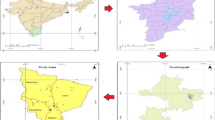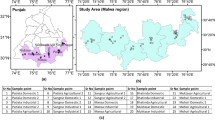Abstract
Suitability of water quality for the drinking and irrigation purposes is indispensable for the endurance of life and sustainability of the ecosystem. The present study is aimed to evaluate the groundwater quality for suitability of drinking and irrigation purposes in the central Gangetic plain area (Bhagarpur district, Bihar), India using the geo-spatial and waterqaulity index (WQI) techniques. Groundwater samples were collected randomly from 45 locations in the pre-monsoon (April -May) and post-monsoon (October-November) season respectively during the period between 2015 and 2016. The different major water quality parameters such as pH, Electrical Conductivity (EC), Total hardness, Calcium (Ca++), Magnesium (Mg++), Sodium(Na+), Potassium (K+), Chloride (Cl-), Carbonate (CO3—), Bicarbonate (HCO3-), and Fluoride (F-) were analyzed using standards methods. Sodium adsorption ratio (SAR) and residual sodium carbonate (RSC) were estimated for suitability of irrigation uses. Pearson’s correlation coefficient was calculated to measure the degree of relation between groundwater variables. The spatial variation maps of these groundwater quality parameters were generated through Inverse distance weightage (IDW) interpolation technique in Arc-GIS software. The pH value of 4.4% of the groundwater samples was found exceeding the acceptable limit established by the WHO (2011)/BIS (2012). Clvalues ranges between 3.24 to 28.74 mg/l-1 in the pre-monsoon season and from 2.50 to 64.98 mg/l-1 in post-monsoon season. Magnesium are cross the limits (<50 mg/l-1) of WHO/BIS in both the pre- and post-monsoon seasons. The F- concentration is higher in both the pre-monsoon and post-monsoon season. The water quality index (WQI) indicates 4.44% of the pre-monsoon samples are good for drinking purposes, whereas the value increases to 31.11% during the post-monsoon in the study area. The higher value of RSC was portrayed in the entire Naugachhia block and the eastern part of the Goradih block for both the season. The higher concentration of sodicity problem is portrayed in the entire Goradih block, north-east of Gopalpur block, and south-west of Naugachhia block for both the pre-monsoon and post-monsoon season. These results will be help planners, decision makers, local peoples, and Government to take necessary measures.
Similar content being viewed by others
References
Adhikary, P.P. and Biswas, H. (2011) Geospatial assessment of groundwater quality in Datia district of Bundelkhand. Indian Jour. Soil Conserv., v.39(2), pp.108–116.
Adhikary, P.P., Dash, C.J., Chandrasekharan, H., Rajput, T.B.S., Dubey, S.K. (2012) Evaluation of groundwater quality for irrigation and drinking using GIS and geostatistics in a peri-urban area of Delhi, India. Arab. Jour. Geosci., v.5, pp.1423–1434.
Agarwal, E., Rajat, A., Garg, R.D., Garg, P.K. (2013) Delineation of groundwater potential zone: an AHP/ANP approach. Jour Earth Syst. Sci., v.122(3), pp.887–898.
Amalraj, A. and Pius, A., (2013) Health risk from fluoride exposure of a population in selected areas of Tamil Nadu South India. Food Science and Human Wellness, v.2(2), pp.75–86.
APHA (2000) Standard Methods for Examination of Water and Waste water, 20th Ed. American Pub. Health Assoc., Washington D.C.
Bhunia, G.S., Shit, P.K., Maiti, R. (2018) Comparison of GIS-based interpolation methods for spatial distribution of soil organic carbon (SOC). Jour. Saudi Soc. Agricul. Sci., v.17, pp.114–126. DOI: 10.1016/j.jssas.2016.02.001
BIS (Bureau of Indian Standards) (2012) Indian standard drinking water specification, Second Revision ISO: 10500:2012, Bureau of Indian Standards, Drinking Water Sectional Committee, FAD25. New Delhi, India.
Brindha, K. and Kavitha, R. (2015) Hydrochemical assessment of surface water and groundwater quality along Uyyakondan channel, south India. Environ. Earth Sci., v.73, pp.5383–5393.
Dengiz, O., Ozcan, H., Koksal, E.S., Baskan, O., Kosker, Y. (2010) Sustainable natural resource management and environmental assessment in the Salt Lake (Tuz Golu) Specially Protected Area. Environ. Monit. Assess., v.161, pp.327–342.
Eaton, E.M. (1950) Significance of carbonates in irrigation waters. Soil Sci., v.69, pp.123–133.
Gouri, K. and Choudhary, S.K. (2017) Fluoride Contamination in Groundwater Sources of Bhagalpur Municipal Corporation Area, Bhagalpur, Bihar. IOSR Jour. Environ. Sci., Toxicology and Food Technology (IOSRJESTFT), v.11(1), pp.45–49.
Goyal, S.K., Chaudhary, B.S. (2010) GIS based study of Spatio-Temporal changes in groundwater depth and quality in Kaithal district of Haryana, India. Jour. Indian Geophys. Union, v.14(2), pp.75–87.
Jha, A.K. and Kumar, U. (2014) A case study of arsenic and fluoride contamination in groundwater of Bhagalpur District. Jour. Chem. Pharma. Res., v.6(11), pp.735–738.
Kalpana, L. and Elango, L. (2013) Assessment of Groundwater quality for drinking and irrigation purposes in Pambar River Sub-Basin, Tamil Nadu. Indian Jour. Environ. Protect., v.33(1), pp.1–8.
Krishna Kumar, S., Bharani, R., Magesh, N.S., Godson, P.S., Chandrasekar, N. (2015) Hydrogeochemistry and groundwater quality appraisal of part of south Chennai coastal aquifers, Tamil Nadu, India using WQIand fuzzy logic method. Appld Water Sci., v.4, pp.341–350.
Mahalingam, B., Ramu, Magdum, Deepali Bhauso, Jayashree, P. (2014) Assessment of Groundwater Quality Using GIS Techniques: A Case Study of Mysore City. Internat. Jour. Engg. Innovative Tech., v.3(8), pp.117–122.
Mahato, M.K., Singh, P.K., Tiwari, A.K. (2016) Hydrogeochemical evaluation of groundwater quality and seasonal variation in East Bokaro coalfield region, Jharkhand. Jour. Geol. Soc. India, v.88(2), pp.173–184.
Mandour, R.A. (2012) Human health impacts of drinking water (surface and ground) pollution Dakahlyia Governorate, Egypt. Appld. Water Sci., v.2(3), pp.157–163.
Marko, K., Al-Amri, N.S., Elfeki, A.M.M. (2014) Geostatistical analysis using GIS for mapping groundwaterquality: case study in the recharge area of Wadi Usfan, westernSaudi Arabia. Arab. Jour Geosci., v.7, pp.5239–5252
Mehrjardi, R.T., Jahromi, M.Z., Mahmodi, S., Heidari, A. (2008) Spatial distribution of groundwater quality with geostatistics (case study: Yazd-Ardakan Plain). World Appld. Sci. Jour., v.4(1), pp.9–17.
Patil, V.T., Patil, P.R. (2010) Physicochemical analysis of selected groundwater samples of Amalner town in Jalgaon district, Maharashtra, India, Electronic Jour. Chem., v.7(1), pp.111–116.
Selvam, S., Manimaran, G., Sivasubramanian, P. (2013) Hydrochemical characteristics and GIS-based assessment of groundwater qualityin the coastal aquifers of Tuticorin corporation, Tamilnadu, India. Appld. Water Sci., DOI:10.1007/s13201-012-0068-8
Selvam, S., Venkatramanan, S., Singaraja, C. (2015) A GIS-based assessment of water quality pollution indices for heavy metal contamination in Tuticorin Corporation,Tamilnadu, India. Arab. Jour Geosci., pp.1–16. DOI: 10.1007/s12517-015-1968-3.
Sharma, D.A., Rishi, M.S., Keesari, T. (2017) Evaluation of groundwater quality and suitability for irrigation and drinking purposes in southwest Punjab, India using hydrochemical approach. Appld. Water Sci., v.7, pp.3137–3150. DOI: 10.1007/s13201-016-0456-6
Shrivastava, V.S., Patil, P.R. (2002) Tapti river water pollution by industrialwastes: A statistical approach. Nat. Environ. Pollut. Tech., v.1(3), pp.279–283.
Singh, A., Sharma, C.S., Jeyaseelan, A.T., Chowdary, V.M. (2015) Spatio–temporal analysis of groundwater resources in Jalandhar district of Punjab state, India. Sustain. Water Resour. Manag., v.1, pp.293–304.
Singh, A.K., Gupta, V.K., Sharma, B., Singla, B., Kaur, P., Walia, G. (2015) What are we drinking? Assessment of water quality in an urban city of Punjab, India. Jour. Family Medicine and Primary Care. v.4(4), pp.514–518. DOI:10.4103/2249-4863.174267.
Tiwari, A.K., Singh, A.K. (2014) Hydrogeochemical investigation and groundwater quality assessment of Pratapgarh district, Uttar Pradesh. Jour. Geol. Soc. India, v.83(3), pp.329–343.
Tiwari, A.K., Ghione, R., Maio, M. De, Lavy, M. (2017) Evaluation of hydrogeochemical processes and groundwater quality for suitability of drinking and irrigation purposes: a case study in the Aosta Valley region, Italy. Arab Jour. Geosci., v.10, pp.264.
Tiwari, A.K., Singh, P.K., Mahato, M.K. (2016) Environmental geochemistry and a quality assessment of mine water of the West Bokaro coalfield, India. Mine Water Environ., v.35(4), pp.525–535.
Verma, D.K., Bhunia, G.S., Shit, P.K., Kumar, S., Mandal, J., Padbhushan, R. (2017) Spatial variability of groundwater quality of Sabour block, Bhagalpur district (Bihar, India). Appld. Water Sci. v.7(4), pp.1997–2008. DOI:10.1007/s13201-016-0380-9.
Verma, D.K., Kumar, S., Mandal, J., Padbhushan, R. (2015) Evaluating quality of groundwater collected from intensively cropped areas in Sabour block of Bhagalpur district, Bihar, India. Ecol., Environ. Conserv., v.21, pp.53–59.
WHO (2006) Guidelines for drinking-water quality, vol 1, Recommendations, 3rd edn. World Health Organization, Geneva.
WHO (2011) Guidelines for drinking-water quality, 4th edn. World Health Organization, Geneva.
Wongsasuluk, P., Chotpantarat, S., Siriwong, W., Robson, M. (2014) Heavy metal contamination and human health risk assessment in drinking water from shallow groundwater wells in an agricultural area in Ubon Ratchathani province, Thailand. Environ. Geochem. Health., v.36(1), pp.169–182.
Yao, X., Fu, B., Lü, Y., Sun, F., Wang, S., Liu, M. (2013) Comparison of Four Spatial Interpolation Methods for Estimating Soil Moisture in a Complex Terrain Catchment. Schumann GJ-P. (Ed.), PLoS ONE. v.8(1), pp.e54660. DOI:10.1371/journal.pone.0054660.
Author information
Authors and Affiliations
Corresponding author
Rights and permissions
About this article
Cite this article
Verma, D.K., Bhunia, G.S., Shit, P.K. et al. Assessment of Groundwater Quality of the Central Gangetic Plain Area of India Using Geospatial and WQI Techniques. J Geol Soc India 92, 743–752 (2018). https://doi.org/10.1007/s12594-018-1097-1
Received:
Accepted:
Published:
Issue Date:
DOI: https://doi.org/10.1007/s12594-018-1097-1




